Lancia Gamma Coupé 2500IE vs Alfa Romeo GTV 6 2.5
Boxing Match These two charismatic children of the 1970s arguably reached full maturity in the 1980s. But does Alfa V6 sportiness trump Lancia boxer-four elegance? Story by Simon Charlesworth. Photography by Michael Ward.
COUPE CONTEST ALFA GTV 6 V LANCIA GAMMA
1980s coupe pair go back to back
Italy in the 1970s certainly had its troubles, and it’s no surprise to find that the two coupes you see here both had troubled beginnings. While Alfa Romeo’s Alfetta GT veered away from its original Giugiaro conception, the Lancia Gamma got embroiled in continental politics. Yet both shine today as beacons of mainstream coupe desirability.
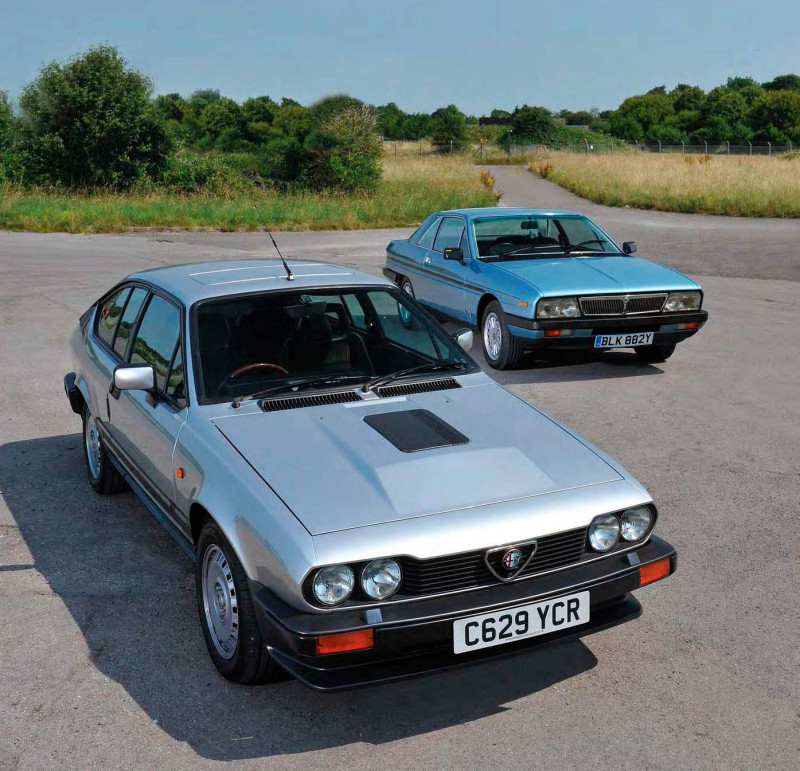
Let’s start with the Lancia, because just as a magpie is drawn to shiny objects, the Gamma Coupé just reels you in. The 1968 ‘Pardevi’ accord between Fiat and Citroën, which produced the Lancia Beta gearbox, was intended to see Citroën’s hydropneumatic suspension installed into the Gamma when the project started in 1970. Indeed the new Lancia was supposed to share much with the forthcoming Citroën CX. Yet what started out as a replacement for Lancia’s executive Flavia/2000 – and then swelled to be more of a Lancia range-topper – was nobbled in 1972. By whom? One Charles de Gaulle, who was indignant that the French marque should be co-operating with a foreign company. This untimely political spanner left Lancia somewhat stranded.
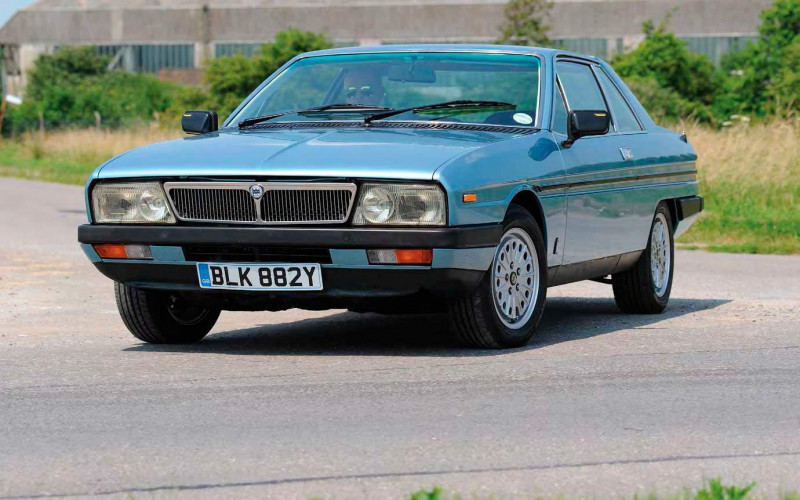
The space beneath the Gamma’s bonnet was always intended to be filled with a new, lightweight, belt-driven, aluminium, flat-four engine. Making the most of Lancia’s experience with the smaller chain driven Flavia/2000 unit, the over-square 2484cc engine was initially carb-fed, realising 140hp and driving the front wheels via either a five-speed manual or four-speed automatic gearbox.
The Gamma’s suspension borrowed heavily from the Beta. The final result was ahead of its time, an all-independent chassis with MacPherson struts, designed under Lancia’s head of development, Sergio Camuffo. Unfortunately, the Gamma had a few mechanical issues during its life – particularly engine niggles and the AP automatic gearbox – and the damage done to its reputation was never truly overcome.
In terms of conception, the Coupé was a genuine surprise. After completing the design of the saloon, Pininfarina unexpectedly presented Aldo Brovarone’s strikingly boxy two-door design to Lancia’s management. It was an easy decision and the Coupé got the green light for production, following the Berlina in the autumn of 1976.
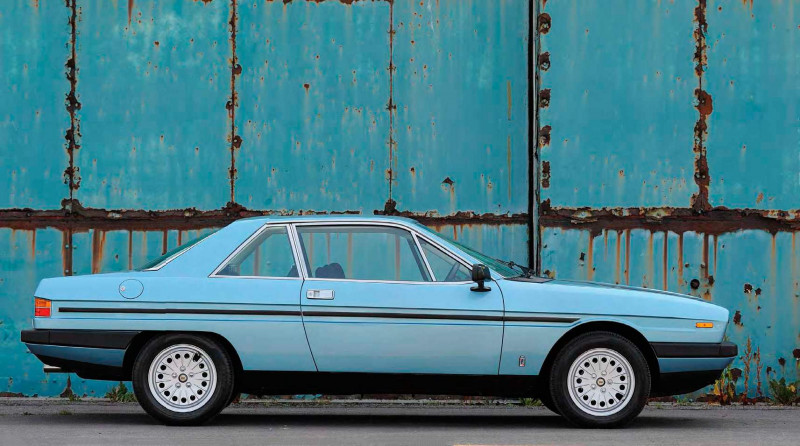
In 1980, it was facelifted with a new grille, alloy wheels and internal trim changes, but the big news was the adoption of fuel injection for the 2.5-litre engine, which improved smoothness and low-down torque. The carburettor model remained an option on the Berlina, but from here on the Coupé was exclusively fuel-injected.
Sadly, by 1984 the Gamma’s plug had been pulled, leaving production totals of just over 15,000 saloons and fewer than 7000 Coupés. Today it is thought that there are just 10 running Coupés left in the UK – that’s a good Alfa GTV show turnout these days – and a mere three or four saloons.
This splendid Gamma Coupé belongs to Steve Mogg. It’s a 1982 2.5ie which he has owned since 2000. “My father bought a new Series 1½ in 1979 and we had that as a family car for three or four years. We went everywhere in it, holidays in the south of France with me and my brother sat in the back. It kind of embedded itself in my memory. So I looked around until I found a car that was really solid. I didn’t care so much about the cosmetics, I just didn’t want a rusty one. I found this one – very solid but the cosmetics were tired.” Repainted in 2001, this S2 has been converted to a manual gearbox and is trimmed in darker, mid-blue Lcloth, which was the result of a pan-European club effort. “It’s a very unusual car that I love driving. I’ve been down to Italy in it. It’s a very pretty car from certain angles – I think it does have good angles and bad angles – but from the right angle it is pretty stunning. I don’t think there’s another Pininfarina coupe that’s this rare for this kind of money.”
Moving east from Turin to Milan, the Alfa Romeo GTV 6 2.5 is a stalwart of the Italian car scene. Based on a shortened Alfetta saloon floorpan – a model developed initially under Orazio Satta with Giuseppe Busso – it took roughly eight years from the original Alfetta launch for the GTV 6 2.5 to reach the market in 1980. Essentially, this was a restyled, upgraded V6 version of the Alfetta GTV 2000, as the four-cylinder car became the GTV 2.0 and the hitherto unloved Busso V6 found a fitting home under a newly power-bulged bonnet. As the Alfetta name neared the end of its service, the GTV underwent a comprehensive and highly successful facelift for the 1980s. This included plastic bumpers, with the front one being raised to create a far more assertive head-on aspect.

Where the SOHC-per-bank Busso V6 had debuted in the unloved Alfa 6 of 1979, the fuel-injected 158hp GTV 6 refused to conform. In fact, it became what could be considered as the most able and popular of Alfa’s post-war six-cylinder models, even earning an enviable racing record in the European Touring Car Championship. GTV 6s were popular with a host of Division Two teams: Alfa Romeo Deutschland, Luigi Racing, Scuderia Autoldi Corse, Jolly Club Milano, Biesse Racing Team and Imberti. All of which explained why Alfa won D2 in 1982, 1983, 1984 and 1985.
The production figures suggest that the battle between Alfa and Lancia was a one-horse race, with Alfa Romeo producing 448,417 Alfetta saloons and 137,579 GT coupes. Of the latter, 22,380 were GTV 6 2.5s, during whose production run many subtle improvement were made until the last pure-bred rear-wheel drive Alfa 2+2 ended production in 1987.
This 1985 Alfa Romeo GTV 6 2.5 was bought by Chris Wright 11 years ago. “It’s the second of four Alfas I’ve purchased. Initially I used the car pretty much every day – it wasn’t a show queen at all. Unfortunately, it then got hit up the back end by a Golf GTI, which caused quite a bit of bodywork damage – although thankfully it didn’t disintegrate as the cynics would have you believe!”
Alex Jupe then repaired the back end and restored around the windscreen where it was starting to corrode, plus it was resprayed. The work was finished in about 2017. “I tend to only use it in the summer months and it’s very reliable,” says Chris. “I think it’s a fantastically good-looking car, although I understand that’s an entirely subjective view. I love the sound and the performance of the Busso engine.
It was a car I’d admired in the 1980s but couldn’t afford. It took quite a bit of looking – about three years to find a half-decent one.
“I’ve always liked Alfa Romeos and I put it down to when I had a weekend/holiday job as a student in a garage. One of our customers was a local GP and he usually had a fleet of four or five cars, and had successfully sand-raced at Southport. He used to say to me, ‘You can take any make of car and give it to me, and the only one I can’t knock the engine out of is an Alfa Romeo.’ He used to lend me his Alfa Romeo Owners’ Club magazines, so I blame him quite a lot – but I’m very appreciative!”
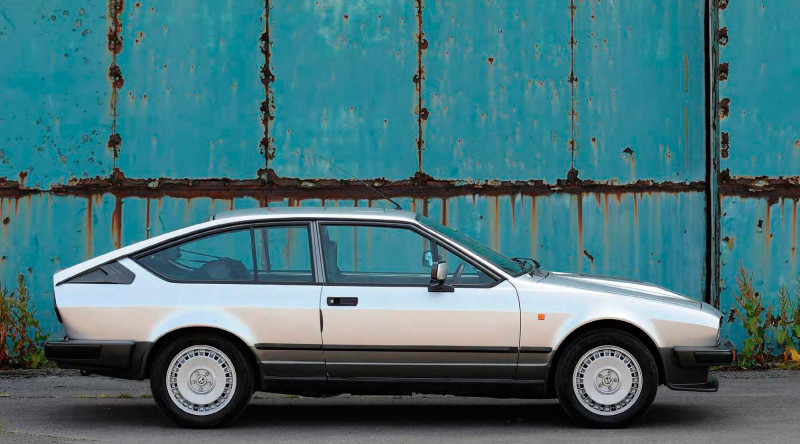
Both cars largely retain their factory spec. The Alfa has an Alex Jupe Motorsport quickshift, relocated fuel pump and high-level brake light, whilst the Lancia has a chunky Nardi steering wheel. The Gamma has the more straightforward driving position, and the more conventional and ergonomic interior, with the only minus being a lack of a rest for your clutch foot. In the Alfa, all seems to be focused on the tacho, right bang in front of you.
As soon as it starts, the Lancia’s big boxer’s offbeat rhythm makes itself known. Unlike the sweet subtlety of a Flavia, initially it sounds like there’s an idling Impreza nearby. The large thumping sound really doesn’t match the svelte Gamma Coupé’s dress sense. At low revs there’s a metallic clatter, like a knight in shining armour dancing an Irish jig. The Betalike gearknob offers a free and positive gearchange quality. Accelerating through the gears, when you extend the boxer beyond 3000rpm, the metallic rattle and throb melt into a pleasant hum, almost like a supersized 2CV. It’s redlined at just over 6000rpm, but to venture to that red-painted territory just feels cruel – 4500rpm is plenty enough.
The Gamma’s steering is light, and being a 1970s power-assisted rack, there is some syrupiness. The long-travel suspension’s ride is supple and comfortable. But if you think you know what’s going to happen through corners, you’d be wrong. The Gamma surprises you with a lack of front-end weight and inertia, although it has plenty of grip and an eerily flat cornering stance. To experience any meaningful roll when dealing with twists and turns would require a track. It really is tenacious, thanks to that low frontal centre of gravity and lack of mass – and in this respect it feels far younger than the Gamma’s true age.
Regular readers will know that, due to my name appearing on an Alfetta logbook, my brain and heart are mounted in series for minimal objectivity. Yet I acknowledge that the GTV 6 is a car that merrily thrills and frustrates on the same journey. The issue is that the heavier V6, when compared to the original twincam, can make it feel a bit ‘normal’. Gone is the incredibly wieldy and light front end; the high polar moment of inertia is compromised; and it feels like a car with a – dare I suggest – front-mounted gearbox rather than its actual rear transaxle.
The bribe, though, is that engine. One of the best V6s ever created, it spoils you with a glorious lullaby beyond 3000rpm. This can be frustrated, however, by the twin-plate clutch, which is tricky, sudden and heavy, and a gearchange that, when not set-up correctly, is like a drunk stumbling through a rubber maze wearing a blindfold. I’m sorry but there is more. Alfa never made the front end as good as the superb de Dion transaxle rear, so the handling can be a bit understeery and disappointing. It just depends on the car you’re in.
Now, if every GTV 6 had been as beautifully set-up as Chris’s specimen, Alfa wouldn’t have been able to build them quickly enough. Yes, it has a quickshift, but it even retains its original-style twin-plate clutch (which is usually the first thing to end up in the bin). Somehow on this GTV 6, changing gears and playing tunes on the Busso is straightforward, allowing you to make the most of what proves to be the more compact, lighter, quicker and faster of today’s pairing.
This GTV 6 doesn’t feel like the slow-witted front is being outplayed by the smarty-pants rear. You can just dial it through corners with minimal roll and steering input, savouring the uncorrupted, lively, analogue steering that’s completely in-synch with the frontend’s lust for cutting the grass on corner apices.
The ride is much firmer than the compliant, comfortable Lancia’s. The Alfa’s driving position and ergonomics, too, are offset and somewhat higgledypiggledy, but that tacho is right where you need it – like sheet music perched on a piano, ready for a great virtuoso to play (although instead it has to make do with me...). All the controls are light and precise, allowing you to get totally lost in the zen-like sporty drive, whilst your ears relish that six-cylinder’s gloriously rich voice. The best GTV 6 I’ve ever driven? Yes. Easily.
VERDICT
Ultimately, these two coupes are as different in character as their spec sheets and body shapes. The Gamma is a deeply enigmatic machine and even now, I’m not sure I completely understand its contradictory character. It’s a comfortable, sleeklooking mile-eater with a good driving position. It points towards a top-end de luxe grand tourer with refined, sophisticated credentials. Yet there it is, that incongruously throbbing four-pot boxer – as if Katherine Jenkins had the voice of Joe Cocker. Some will – and do – find such a niche Lancia intriguing and enthralling, but my preoccupied mind lies elsewhere. Charmed and captivated by a GTV 6 that doesn’t need excuses, the Milanese coupe finally delivers on the promises Alfa Romeo made over 40 years ago.
Many thanks to Steve Mogg, Chris Wright, Tim Heath and Alex Jupe for their help with this feature
Plastic-bumpered 1980s GTV looks great. Busso V6 is a pure delight, while beautiful set-up on this car delivers superb handling
TECHNICAL SPECIFICATIONS Alfa Romeo GTV 6 2.5
- ENGINE: 2492cc V6 SOHC per bank
- INDUCTION: Bosch L-Jetronic EFI
- MAX POWER: 158hp at 5600rpm
- MAX TORQUE: 135lb ft at 4000rpm
- TRANSMISSION: 5-sp manual transaxle, rear-wheel drive
- SUSPENSION: Double wishbones, torsion bars (front), De Dion tube, Watt linkage (rear), anti-roll bars (front and rear)
- BRAKES: Discs front and rear
- TYRES: 195/60 HR15
- DIMENSIONS: 4260mm (L), 1664mm (W), 1330mm (H)
- WEIGHT: 1210kg
- MAX SPEED: 132mph
- 0-62MPH: 8.8sec
“You can dial the Alfa through corners with minimal roll and steering input, savouring the uncorrupted, lively, analogue steering ”
Side profile is Gamma’s best angle. Front-wheel drive delivers crisp, modern handling but flat-four engine feels out of place.
TECHNICAL SPECIFICATIONS Lancia Gamma Coupé 2500IE
- ENGINE: 2484cc flat-4-cyl SOHC per bank
- INDUCTION: Bosch L-Jetronic EFI
- MAX POWER: 140bhp at 5400rpm
- MAX TORQUE: 145lb ft at 3800rpm
- TRANSMISSION: 5-speed manual (4-sp auto option), front-wheel drive
- SUSPENSION: MacPherson struts, wishbones, anti-roll bars
- BRAKES: Discs front and rear
- TYRES: 195/60 HR15
- DIMENSIONS: 4485mm (L), 1730mm (W), 1330mm (H)
- WEIGHT: 1290kg
- MAX SPEED: 120mph
- 0-62MPH: 9.4sec
“It’s really tenacious through corners, thanks to a low frontal centre of gravity and lack of mass… it feels far younger than its true age”


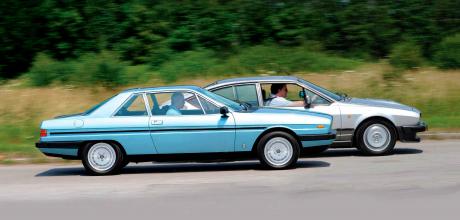
ORIGINAL IS BEST
Having owned two GTV 6s for 34 and 25 years (and still have them), I am very pleased to see a test in your February 2022 issue with one that is almost as factory built, especially with the original wheel rims and tyres. I am sure you get a purer drive that is truer to what the car really should be like. Mine are also original, apart from Koni dampers, and both drive superbly. Once you have a good one, they are very addictive cars indeed. My red one is attached.